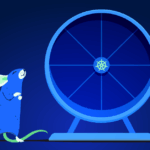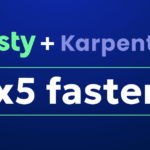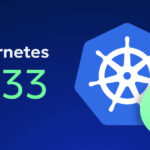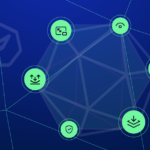
Intelligent Automation: What’s the Missing Piece of Today’s AIOps?

CEO and Co-founder
(This post was originally published on The New Stack)
Back in 2016, when Corona was only a beer and we were still laughing at the thought of a Trump presidency, Gartner coined the term AIOps. This marriage of Artificial Intelligence and IT Operations had a lot of promise, and since then, it’s had varied success in improving both manual processes and smart decision making with the help of Big Data.
So let’s take a deep-dive and think about where this kind of intelligent automation has made tidal waves – and where it’s still only seeing ripples.
What Are the Goals of AIOps?
Gartner talks about AIOps as any system combining Big Data and Machine Learning to automate IT operations processes, which includes (but isn’t limited to) event correlation, anomaly detection and determination of causality. In the imagined words of Chandler Bing – could that BE any broader?
The truth is that anywhere IT operations are using AI to make their processes more effective can be called AIOps. So perhaps it’s more important to see what areas have been revolutionized by AIOps so far, and take a predictive look at what could be the Next Big Thing.
What Has AIOps Achieved So Far?
Up until now, AIOps has mostly been used in the context of monitoring. As a buzzword, people tend to think of the term in relation to creating baselines for your data and then alerting to any deviations, connecting multiple sources of information to find the root cause for a problem. These are powerful use cases and are allowing businesses to find correlations that they might not have achieved without AI. For example, you might find that poor bandwidth in a specific region led to an increase in tickets from customers within that location, or that you have idle cloud resources that are costing you in storage or compute costs behind the scenes, allowing you to make manual changes to optimize costs.
However, in many ways, categorizing AIOps as just monitoring and detection doesn’t make it that different from the previous category of IT Operations Analytics, where companies would look at operational data, including logs and security feeds, and then aggregate these to make smarter decisions.
To get more out of AIOps, companies need to move past simple monitoring use cases, and look towards management of the cloud with the help of automation.
AIOps for Cloud Provisioning and OptimizationThere’s no doubt that the repetitive nature of monitoring and anomaly detection makes it a perfect AIOps use case. However, to see the real benefits of AIOps, we need to go further. Cloud provisioning and optimization are two exciting and upcoming areas for AIOps to improve and could offer advanced cloud management and control in a way that has not been explored to its full potential yet. Think about how AI could not only establish a baseline for compute or storage and then alert you to a spike, but take the next step to reserve instances or shut down resources that are not needed or which are costing you more than they should.
For this to work, a number of elements of AIOps need to come together and work in harmony:
- Traditional AIOps Monitoring: We’re not suggesting throwing out the baby with the bathwater. Automation using AIOps relies on the same innovation we already depend on. Organizations will need a deep understanding of cloud infrastructure, including real-time information into usage, as well as trends and predictions for future behavior. Logs need to be ingested immediately at scale and be both aggregated and analyzed in context to create baselines and detect anomalies.
- AIOps Automation: Even a full team of engineers couldn’t handle the manual processes it would take to keep a cloud running at peak performance and to the lowest possible costs in real-time. Robotic Process Automation (RPA) and AI can take this task off the hands of your DevOps teams, with automated provisioning that uses the information gleaned from continuous monitoring systems to trigger smart decision making behind the scenes, 24/7. Developers get exactly the resources they need when they need it and you never spend a cent more than is required. Now isn’t that the dream?
- Continuous Optimization: While AIOps was traditionally aimed at IT Operations teams (just call us Sherlock), you can immediately see how if you move away from monitoring towards management capabilities – you’re taking the weight off from many other parts of the business, including Finance, DevOps and engineers, too. It’s not just about beating alert fatigue (although that’s great, don’t get us wrong), it’s about implementing FinOps processes that leverage AI to add accuracy and control to your abilities on the cloud. This will only improve over time, as like any good algorithm, the more it gets up close and personal with your data – the better these results will be.
The Face of AIOps Has Changed: Management and Automation Will Be the New Benefits of Cloud AIOPs
Back in 2018, studies showed that cost, (52%) complexity (29%) and technological limitations (29%) were the reasons that people were shying away from onboarding AIOps into their organization. In 2021, in a fascinating twist, according to PWC, the main benefits that companies are now seeing from wholly embracing AI are exactly the same; cost savings (70%), operating more efficiently (64%) and intelligently improving decision making (75%). What used to be blocking the way is now opening the door for today’s cloud leaders.
Five years since its conception, it’s time to stop seeing AIOps as just a new way of monitoring your environment, and start putting this strategy into action where it can provide true ROI – in provisioning and optimizing the ever-changing complexities of the cloud.
Looking to optimize your cloud with AIOps? Chat with one of our experts to learn more about Zesty’s intelligent cloud automation technology.
Related Articles
-
 Why it’s time to get off the manual Kubernetes optimization treadmill
Why it’s time to get off the manual Kubernetes optimization treadmill
August 14, 2025 -
 The endless cycle of manual K8s cost optimization is costing you
The endless cycle of manual K8s cost optimization is costing you
July 2, 2025 -
 This is the #1 cloud budget killer (and it’s easier to fix than you think)
This is the #1 cloud budget killer (and it’s easier to fix than you think)
June 16, 2025 -
 K8s users were waiting years for this, and v1.33 just made it real
K8s users were waiting years for this, and v1.33 just made it real
June 12, 2025 -
 Why Most K8s Optimization Strategies Fail (And How to Fix Yours)
Why Most K8s Optimization Strategies Fail (And How to Fix Yours)
May 20, 2025


